Abhishek Bihani

Ph.D. in Petroleum Engineering, University of Texas at Austin
Data Scientist, Tignis Inc
View My LinkedIn Profile
Bio
I am a Data Scientist using Machine/Deep Learning, Time Series Analysis, Image Processing, and Physics-informed neural networks (PINNs) in my work.
I have experience building surrogate models of complex processes in industry and academic settings; I have worked on a variety of projects ranging from process control to minimize wafer bowing in the semiconductor industry to modeling subsurface geologies for carbon capture and storage (CCS) & petroleum exploration.
I am passionate about applying data science techniques to help analyze complex and huge datasets faster, objectively, and more accurately. I believe today’s tools and technology can allow us to extract the maximum possible information from the different available data sources so that we can use it to make optimal decisions that have a high impact on the end-user. For example, I was the co-lead for data analysis of a survey of Canadian parliamentarians to understand the impact of COVID-19 on how they digest scientific data and how it affected their policy-making.
I did my Ph.D. at the University of Texas at Austin, where my doctoral research involved analyzing hydrocarbon/CO2 flow in rocks through image analysis, semantic image segmentation using CNNs, and fluid flow simulations (eg. LBM, DEM etc.) to reduce risk during petroleum exploration or CO2 sequestration. My Master’s research involved investigating gas hydrate deposits in Northern Gulf of Mexico to understand methane migration and accumulation in heterogeneous rocks using petrophysics, thermodynamics, and machine learning.
Before graduate school, I completed my Bachelor of Petroleum Engineering from the University of Pune and then I worked as a Reservoir Engineer at Oil India Limited where our team improved oil recovery through reservoir and well-level analysis for 500+ wells using statistical analysis and modeling.
Ph.D. Research
Mudrocks are a type of rock that act as geological seals for CO2 stored underground or for petroleum in subsurface reservoirs. They prevent leakage by stopping the fluids from flowing upwards through them. However, they can fail if the buoyant pressure of the trapped fluid overcomes their breakthrough pressure.
Through a combination of techniques like pore-network modeling, deep-learning aided image analysis, and lattice Boltzmann simulations, I studied the structure of the mudrock seals to determine the conditions when the caprock can fail and permit flow of the underlying stored fluid. For this purpose, I reconstructed the 3D rock structures (and the space between them) from scanning electron microscope images and conducted flow simulations using high-performance computing resources. I found that correlated heterogeneity (connected larger spaces between rock grains) can greatly increase chances of CO2/hydrocarbon leakage through the seal. I conveyed my inferences to my research sponsor, Equinor, as well as other researchers through conferences and papers for reducing the risk during petroleum exploration and carbon sequestration.

The following video shows comparison of an upwards percolating non-wetting fluid (green) such as oil, natural gas or CO2 in two grain packs (brown), one with low silt (left) and another with high silt (right). Both, the low silt (23%) and high silt (57%) grain packs have 46% porosity. The fluid flows more easily as the pressure across the grain packs increase. It can be seen that more fluid percolation occurs and earlier breakthrough occurs in the high silt grain pack due to larger pore space between the grains.
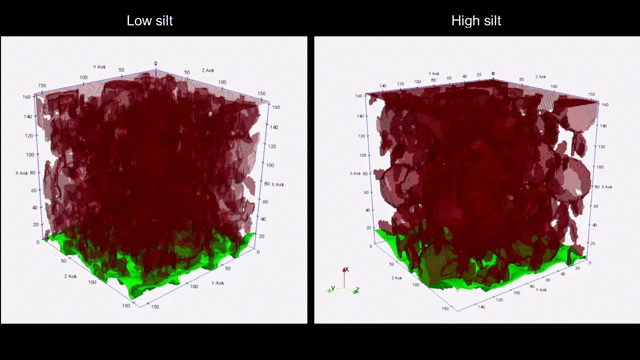
Portfolio
Constructing a Synthetic NMR Well-log using Machine Learning
Generated a workflow for synthetic reconstruction of a missing nuclear magnetic resonance (NMR) well log from other well logs (Gamma Ray, Caliper, Resistivity logs and the interpreted porosity) at a Gulf of Mexico location, through feature engineering, time-series analysis techniques, and multivariate polynomial regression modeling using the Scikit-learn library to increase the training R2 value from 0.26 (multivariate linear regression) to 0.54.
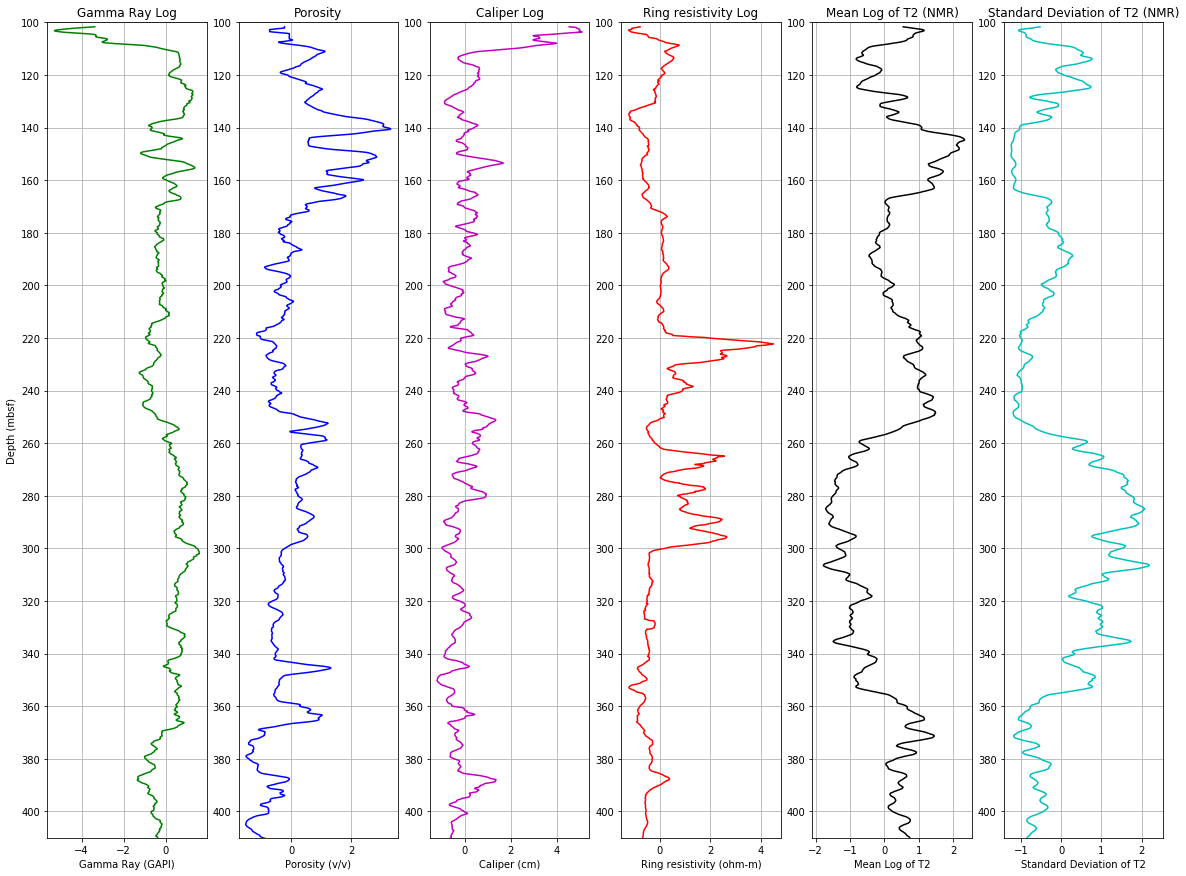
MudrockNet: Semantic segmentation of mudrock SEM images
Constructed a conventional image processing and segmentation (MATLAB) workflow for ground-truth, and a convolutional neural network segmentation model termed MudrockNet (using Deeplab-v3+ architecture with TensorFlow) to identify features like pores, silt grains, and clay from scanning electron microscope (SEM) images with > 90% pixel-accuracy, and mean intersection over union (mIoU) test results (> 0.65) better than the random forest method (~ 0.5).
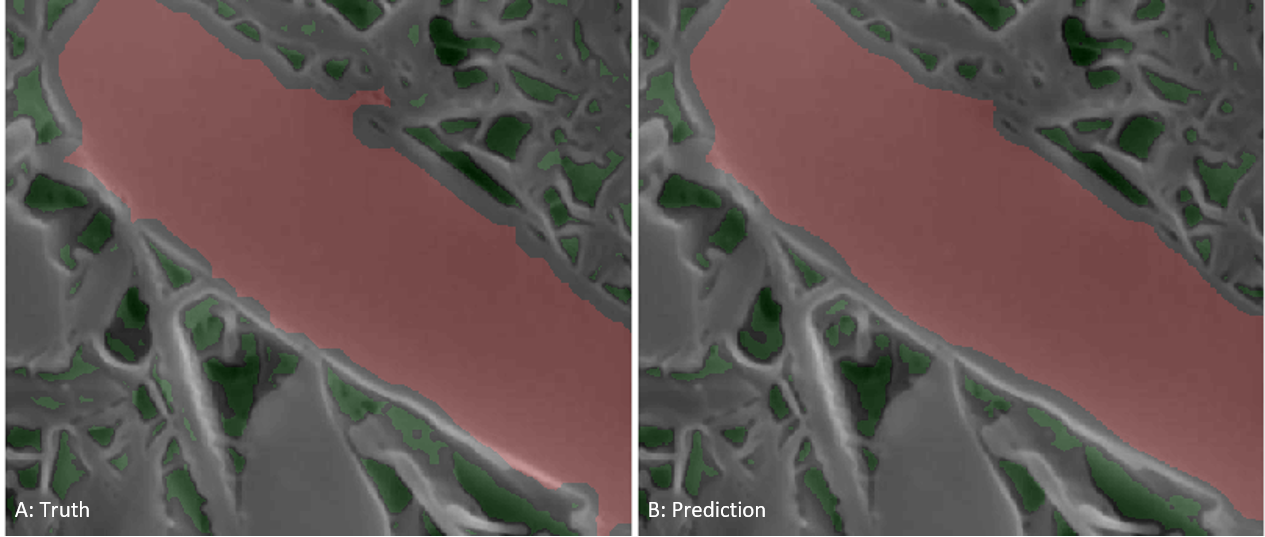
Multiphase LBM Toolbox: Permeable media analysis using the Palabos library and in-house codes
Co-developed and released an open-source computational simulation toolbox for modeling multiphase flows in porous media on high-performance computing (HPC) resources, and characterizing petrophysical properties of complex porous geometries. The toolbox uses the Palabos library (C++) for lattice Boltzmann (LBM) simulations and in-house scripts created in MATLAB for calculating petrophysical properties like capillary pressure curves, relative permeability and the percolation pathway across grain packs/image slices in complex porous geometries .
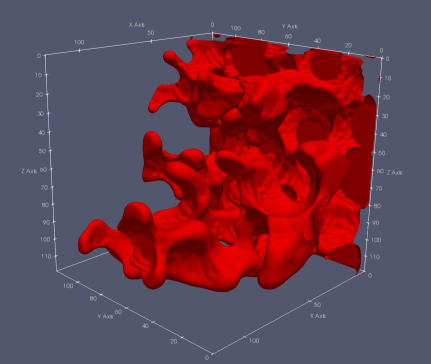
Uniaxial Compaction and Force-chain Analysis of Bidisperse Grain packs
Created a workflow to simulate creation of a bidisperse (two-sized) grain pack under gravity and study the grain behavior subjected to uniaxial compaction, using the LIGGGHTS library (C++) on HPC resources. Scripts for post-processing like calculating, plotting and visualizing coordination numbers and force chains to study the grain behavior when subjected to compaction are also provided.

Home Credit Default Risk Recognition
Trained a binary classifier in Python to recognize the risk of housing loan default in imbalanced data using a complete end-to-end machine learning workflow. Used ETL processes to connect relational databases through automated feature engineering, and applied machine learning methods like logistic regression, random forest, and gradient boosting (Scikit-learn, XGBoost, LightGBM) for understanding client factors that cause loan default. Improved ROC AUC from 0.745 (base case) to 0.786 on the test dataset with K-fold cross-validation and hyperparameter tuning methods like grid/random search, and Bayesian optimization.
Science Policy Projects
Impact of the COVID-19 pandemic on the use of science in policymaking
Designed a survey for Canadian MPs and senators regarding the access, use, and exchange of scientific knowledge in Parliament to study the effect of the COVID-19 pandemic, as part of the team from the Canadian Science Policy Centre (CSPC), where a total of 26 Parliamentarians participated in this study. I co-led the analysis of the survey data and we found that a majority of respondents reflected that the availability and applicability of scientific knowledge in policy-making has increased, as compared to before the pandemic. However, the survey results also highlighted that all respondents (regardless of political affiliation) found that misinformation and disinformation have become more challenging to sift through and address.
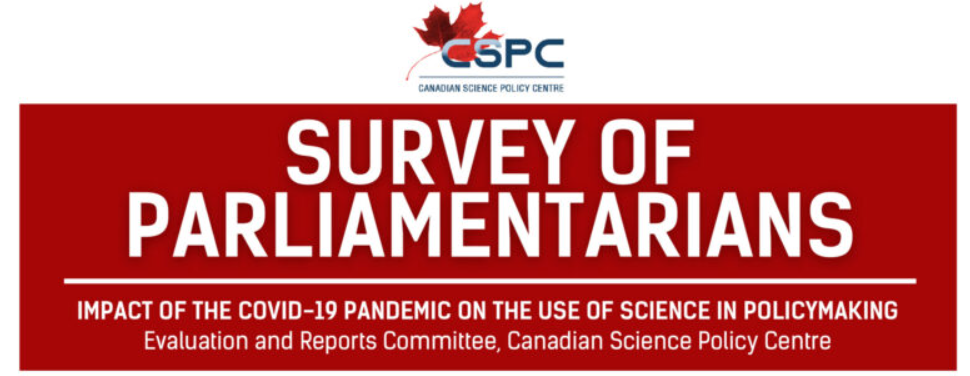
Canadian Science Policy Magazine 2023
Served as Editorial Co-chair for the 2023 edition of the Canadian Science Policy Magazine to publish diverse science-based opinions of Canadian leaders from the government, industry, and academia on relevant current topics like climate change, space exploration, international scientific cooperation, and AI regulation.
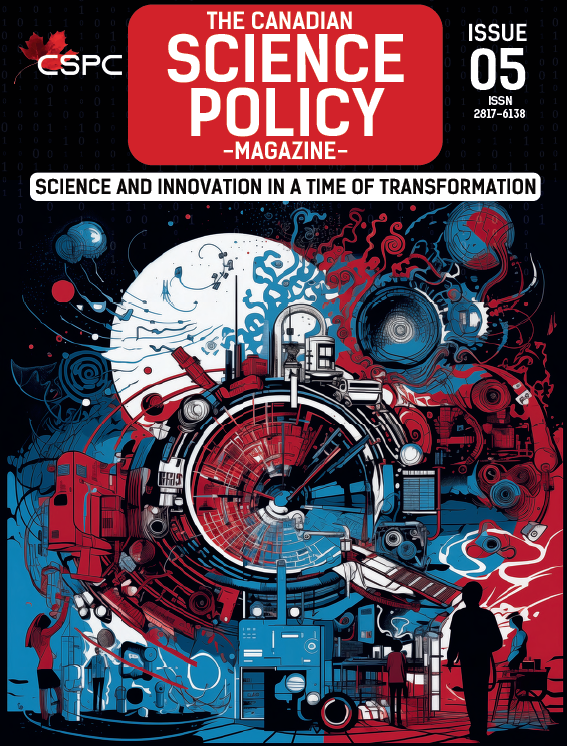
Skills
Programming: MATLAB, Python, C++, Git, Bash, SQL
Libraries: NumPy, SciPy, Pandas, Scikit-learn, Matplotlib, Seaborn, OpenCV, PyTorch, TensorFlow, Keras, PySpark, XGBoost, LightGBM, Featuretools, Hyperopt, Palabos, LIGGGHTS
Analytics: Tableau, SPSS
Cloud Computing: AWS (SageMaker, S3, EC2), Azure Machine Learning
Technical Knowledge: Machine / Deep Learning, Computer Vision, Image Analysis, Time-series Analysis, Surrogate Modeling, Computational Fluid Dynamics (CFD) in Porous Media, Digital Rock Physics, Petrophysics, Reservoir Engineering
Certifications
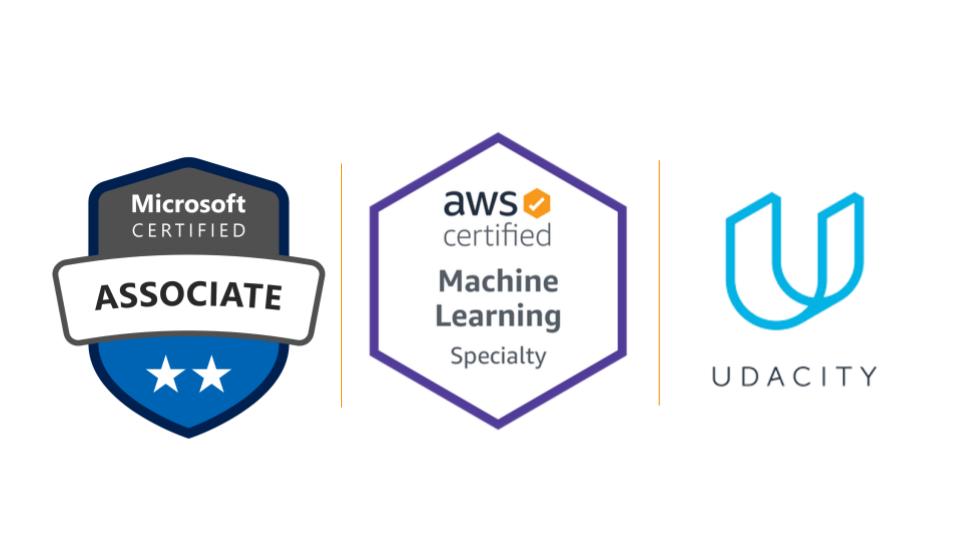
Microsoft Certified: Azure Data Scientist Associate. (2024). Microsoft.
AWS Certified Machine Learning - Specialty (MLS-C01) (2020). AWS.
Computer Vision Nanodegree (2020). Udacity
Machine Learning Engineer Nanodegree (2020). Udacity
Education
The University of Texas at Austin, USA
Ph.D. - Petroleum Engineering, May 2020
M.S. - Petroleum Engineering, May 2016
Maharashtra Institute of Technology, University of Pune, India
B.E. - Petroleum Engineering (Honors: Silver Medalist), May 2011
Experience
Data Scientist – Tignis Inc., Mar 2021 – Present
Graduate Researcher – Center for Subsurface Energy & the Environment (CSEE), University of Texas at Austin, Aug 2014 – May 2020
Reservoir Engineer – Geology & Reservoir Engineering Department, Oil India Limited (OIL), Oct 2011 – Jul 2014
Undergraduate Intern – Oil and Natural Gas Corporation of India (ONGC), Jan 2011 – Jun 2011
Summer Intern – Essar Oil Limited, Jun 2010 – Jul 2010
Publications
A) Theses / Dissertations
Bihani A., (2020). Grain-scale controls on seal integrity in mudrocks: capillary entry pressure and permeability prediction. Ph.D. Dissertation. http://dx.doi.org/10.26153/tsw/14843. PDF
Bihani A., (2016). Pore Size Distribution and Methane Equilibrium Conditions at Walker Ridge Block 313, Northern Gulf of Mexico. M.S. Thesis. http://hdl.handle.net/2152/38192 PDF
B) Peer-Reviewed Journal Articles
Bihani A., Daigle H., Santos J., Landry C., Prodanović M., Milliken K. (2022). MudrockNet: Semantic Segmentation of Mudrock SEM Images through Deep Learning. Computers & Geosciences. https://doi.org/10.1016/j.cageo.2021.104952. PDF
Santos J., Gigliotti, A., Bihani A., Landry C., Hesse, M., Pyrcz, M., Prodanović M. (2022). MPLBM-UT: Multiphase LBM library for permeable media analysis. SoftwareX. https://doi.org/10.1016/j.softx.2022.101097 PDF
Daigle, H., Cook, A. E., Fang, Y., Bihani, A., Song, W., Flemings, P. B. (2020). Gas-driven tensile fracturing in shallow marine sediments. Journal of Geophysical Research- Solid Earth. https://doi.org/10.1029/2020JB020835. PDF
Bihani A., Daigle H. (2019). On the Role of Spatially Correlated Heterogeneity in Determining Mudrock Sealing Capacity for CO2 Sequestration. Marine and Petroleum Geology, 106(106), 116–127. https://doi.org/10.1016/j.marpetgeo.2019.04.038. PDF
Bihani A., Daigle H., Santos J., Landry C., Prodanović M., Milliken K. Preprint. Investigating Silt Bridging in Marine Muds of the Kumano Forearc Basin through Image Analysis. PDF
Bihani A., Daigle H. Preprint. Seal Capacity, Force Chains, and Percolation in Silt-Clay Mixtures. Preprint. https://doi.org/10.1002/essoar.10504349.1. PDF
C) Conference and Non-reviewed Publications
Bihani A. (2018). The Effects of Lifting the U.S. Oil Export Ban on Market Equilibrium. Journal of Petroleum Resource Economics, October. PDF
Daigle H., Cook A., Malinverno A., Nole M., Bihani A., Andris R., Wei L., Hillman J. (2017). P 1693- Methane transport and accumulation in coarse-grained reservoirs in the Terrebonne Basin, northern Gulf of Mexico, 9th International Conference on Gas Hydrates, June 25-30, Denver, CO. PDF
Jain D., Bihani A. (2014). PETROTECH A-2238: Crude Oil Viscosity Correlations: A Novel Approach for Upper Assam Basin. Petrotech Conference, 12-15 Jan, New Delhi, India. PDF
Haindade Z., Bihani A., Javeri S., Jere C. (2012). SPE 157119: Enhancing Flow Assurance using Co-Ni Nanoparticles for Dewaxing of Production Tubing. SPE International Oilfield Nanotechnology Conference and Exhibition, 12-14 June, Noordwijk, The Netherlands.https://doi.org/10.2118/157119-MS. PDF
Padalkar C., Arora A., Punase A., Patwardhan S., Bihani A. (2012). P-092: Improved Core recovery using in-situ freezing. 9th Biennial International Conference and Exposition on Petroleum Geophysics. 16-18 February, Hyderabad, India. PDF
Arora A., Bihani A., Padalkar C., Punase A., Patwardhan S. (2011). IPTC 14669: Side-wall Coring: Advanced In-situ Freeze-Core Technique. International Petroleum Technology Conference, 15-17 November, Bangkok, Thailand. https://doi.org/10.2523/IPTC-14669-MS. PDF
Punase A., Bihani A., Patane A., John A., Arora A., Padalkar C. (2011). SPE 142658: ‘SOYBEAN SLURRY’- A New Effective, Economical and Environmentally Friendly Solution for Oil Congealing. SPE Project and Facilities Challenges Conference at METS, 13-16 Feb, Doha, Qatar. https://doi.org/10.2118/142658-MS. PDF
D) Oral Presentations
Bihani A., Daigle H., Santos J., Landry C., Prodanović M., Milliken K. (2019). H44B-06: Insight into the Sealing Capacity of Mudrocks determined using a Digital Rock Physics Workflow. AGU Fall Meeting, 9-13 December, San Francisco, USA. Abstract
Bihani A., Daigle H. (2018). Grain-scale Modeling of Seal Capacity in Heterogeneous Mudrocks. Center for Petroleum and Geosystems Engineering Research Showcase, 23rd August, Austin, USA.
Bihani A., Daigle H. (2018). Investigating Capillary Pressure Behavior in Mudrocks through Grain Scale Modeling. Interpore Annual Meeting, 14-17 May, New Orleans, USA. Abstract
Bihani A., Mundhe P. (2014). A Review of Water Injection Operations and Requirements in Oil India Limited. March 14th, Geology and Reservoir Department, Oil India Limited. Duliajan, Assam, India.
Bihani A. (2013). An Overview of High Pour-Point Oil and Heavy Oil Reserves in Upper Assam Basin. December 26th, Geology and Reservoir Department, Oil India Limited. Duliajan, Assam, India.
E) Poster Presentations
Bihani A., Daigle H., Santos J., Landry C., Prodanović M., Milliken K. (2019). Insight into the Sealing Capacity of Mudrocks determined using Digital Rock Physics. TACC Symposium for Texas Researchers (TACCSTER), 26-27 September, Austin, TX, USA. http://dx.doi.org/10.26153/tsw/6874. PDF
Bihani A., Daigle H. (2019). Investigating Sealing Capacity and Percolation in Mudrocks through Grain Scale Modeling. Presented at the Spring 2019 Virtual Poster Showcase, American Geophysical Union, Washington, DC.
Bihani A., Daigle H. (2019). Poster 79: Investigating Capillary Pressure Behavior in Mudrocks through Grain Scale Modeling. Graduate and Industry Networking Conference, 5 February, Austin, TX. Abstract
Bihani A., Daigle H., Cook A., Glosser D., Shushtarian A. (2015). OS23B-1999: Pore Size Distribution and Methane Equilibrium Conditions at Walker Ridge Block 313, Northern Gulf of Mexico. AGU Fall Meeting, 14-18 December, San Francisco, USA. Abstract
Bihani A., Haindade Z., Jain D. (2012). A study on Electrolysis assisted Gas-Lift for Dewatering CBM Reservoirs. Association of Petroleum Geologists Conference, 30 September, Duliajan, Assam, India.
F) Published Datasets
Bihani, A., & Daigle, H. (2019, March 5). Bidisperse sphere packs generated under gravity. Digital Rocks Portal. http://doi.org/10.17612/P74T20. Data set
Bihani, A., Daigle, H., Prodanovic, M., Milliken, K., Landry, C., & E. Santos, J. (2020, January 20). Mudrock images from Nankai Trough. Digital Rocks Portal. https://doi.org/10.17612/BVXS-BC79. Data set
G) Published Code Repositories
Bihani, A., & Daigle, H. (2020, September 9). Uniaxial Compaction and Force-chain Analysis of Bidisperse Grain Packs. Zenodo. http://doi.org/10.5281/zenodo.4021433. Code
Santos J. E., Bihani, A., & Landry, C. J. (2020, May 25). MP-LBM-UT: Multiphase LBM Toolbox for permeable media analysis. Zenodo. http://doi.org/10.5281/zenodo.3842280. Code
Professional Development
Awards
Department of Petroleum and Geosystems Engineering Research Award, GAIN Conference Austin, 2019
Award for best research poster among 20+ candidates
Advanced Communicator Bronze / Competent Leader, Toastmasters International, 2011
Awards for completing 20 public speaking assignments and holding 10+ roles in Toastmasters meetings
Ravindra Kulkarni Silver Medal, Maharashtra Institute of Technology, 2011
Award for 2nd highest grade in graduating class of 70+ students
Grants and Fellowships
Statoil/Equinor Fellowship, UT Austin, 2016 – 2019
Doctoral Fellowship for 3 years of $58,000 per year for studying flow in porous media through numerical simulations
Research Fellowship, U.S. Department of Energy, UT Austin, 2014 – 2016
Masters Fellowship for 2 years of $55,000 per year for studying deposition and flow of methane hydrates in the Gulf of Mexico
Service
Co-Chair, Editorial Committee, Canadian Science Policy Centre, 2021 - Present
Source and edit articles from distinguished people relevant to the Canadian science policy space
Project Co-Lead, Evaluation and Reports Committee, Canadian Science Policy Centre, 2021 - 2023
Create surveys, analyze data and write reports for Canadian Science Policy Centre
Graduate Faculty Selection Committee, UT Austin, 2017 – 2019
Interviewed potential new department faculty, met external department reviewers, and conducted outreach activities
Young Professionals Committee - Society of Petroleum Engineers, Duliajan Section, 2012 - 2014
Organized quarterly Distinguished Lecture Programs, conducted outreach activities to raise awareness about energy production and conservation
Presiding Officer – Dibrugarh Constituency, Indian Parliamentary Election, Election Commission of India, 2014
Supervised team of six allowing 749 people to vote in the Indian Parliamentary election of 2014
Vice President, Public Relations, Toastmasters Club of Pune – West, 2010 – 2011
Promoted Toastmasters to the general public and conducted PR activities to increase membership strength by maintaining club website, editing club magazine, and interviewing with local news media
President, Society of Petroleum Engineers Student Chapter, 2010 – 2011
Organized national-level conference by raising 6000 USD and received the Gold Standard award for exceptional work
Editor, Society of Petroleum Engineers Student Chapter, 2009 – 2010
Enabled design and publication of annual departmental magazine by assembling competent team, delegating work, filtering and editing of submitted articles while meeting editorial deadlines
Webmaster, Toastmasters Club of Pune, 2009 – 2011
Maintained and updated club website, posted new articles and sent out periodic invitations for the weekly meeting
Memberships in Professional Societies
Member, Canadian Science Policy Centre (CSPC)
Member, Toronto Machine Learning Society (TMLS)
Member, American Geophysical Union (AGU)
Member, Society of Petroleum Engineers (SPE)
Member, International Society for Porous Media (Interpore)
Member, The Computer Vision Foundation (CVF)
Member, Society of Petrophysicists and Well Log Analysts (SPWLA)
Teaching Experience
Role: Teaching Assistant
Course: Petroleum and Geosystems Engineering Design
Period: Fall - 2019
Instructor: Dr. Hugh Daigle
Responsibilities:
Grading fortnightly progress reports and holding office hours for a senior design project about field development and reservoir management, consisting of through oil-in-place estimation, decline curve analysis, material balance studies, and drainage radii calculations using a combination of available field data.
